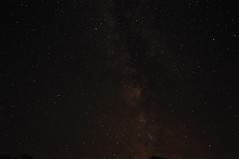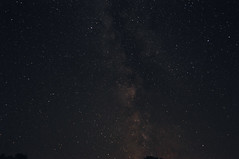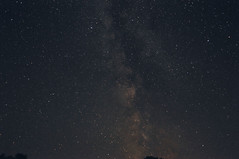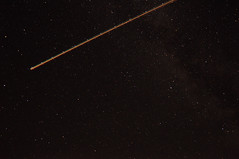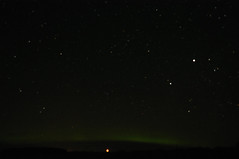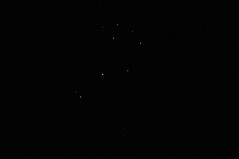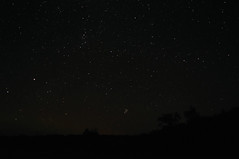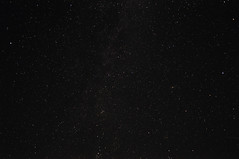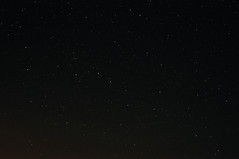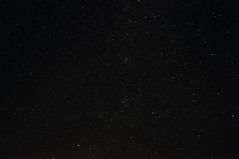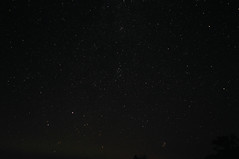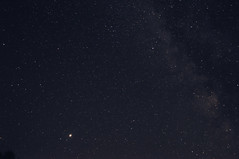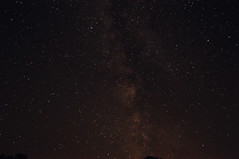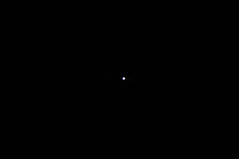October is a good month for observing. The sky is darker earlier, it's still not terribly cold outside (we hope), and there are different objects to see. For example, the Orion constellation is up and with it, the Orionid meteor shower.
On Oct. 8 at about 6 a.m., Venus should be shining brightly near the eastern horizon. Below that, depending where you are, you might spot Mercury and Saturn. By Oct. 13, at about 6:30 a.m., Saturn will have moved to the upper left of Venus. On Oct. 16, in the eastern sky, just before dawn, there should be a conjunction with the crescent Moon and Venus and Saturn. Then on Oct. 26 or 27, the Moon and Jupiter should be in conjunction at just three degrees apart.
A major event this month is the lunar landing of the LCROSS lunar rover. I believe it should be visible if you have a 10" or larger telescope. There is a countdown clock on the right side of this page.
Another important event this month is the RASC Saskatoon Centre open house at the Sleaford dark site. It is located about 65 kms east of Saskatoon and offers great celestial viewing. This event will be held on Friday, Oct. 23 and Saturday, Oct. 24. There will be a convoy of cars leaving from the east end of the Saskatoon Field House parking lot at 7 p.m. on both nights. The Sleaford site is operated jointly by the RASC Saskatoon Centre and the U of S Department of Physics and Engineering Physics. RASC club members will set up their own telescopes, in addition to the U of S telescopes that are setup there. For more information call 966-6429. Make sure to take warm, weather appropriate clothing.
Additional viewing events for October:
Oct. 7 - Moon 0.1 deg N of Pleiades (M45)
Oct. 8 - Draconid meteors peak; Mercury 0.3 deg S of Saturn
Oct. 10 - Moon 1.2 deg N of M35 (open star cluster in Gemini)
Oct. 12 - Occultation of the Moon and Mars
Oct. 13 - Moon at perigee (369067 kms)
Oct. 15 - Zodiacal light visible in eastern sky before morning twilight for the next two weeks
Oct. 21 - Orionid meteors peak
Oct. 25 - Moon at apogee (404166 kms)
Showing posts with label Jupiter. Show all posts
Showing posts with label Jupiter. Show all posts
Tuesday, October 6, 2009
Tuesday, September 1, 2009
The Moon with Jupiter
I'm not sure if it was an official conjunction tonight, but in my world it was. The Moon and Jupiter were close enough to get in the same frame when taking pictures tonight. For some reason, my camera was not behaving, so I was only able to get a couple of decent shots.


These next two photos were taken by using the multiple exposure function on my Nikon D90. I took two exposures; one of the Moon, then adjusted the settings, and snapped Jupiter.




These next two photos were taken by using the multiple exposure function on my Nikon D90. I took two exposures; one of the Moon, then adjusted the settings, and snapped Jupiter.


Sunday, August 23, 2009
Aurora, Galaxies, and Jupiter, Oh My
I went out to the RASC Saskatoon Centre's dark site a few nights ago to capture some images. The sky was amazingly clear, until the dew started to fall. However, I still managed to snap some neat stuff that I've never photographed before. The night was full of wonderful sights, including Aurora, Jupiter, Milky Way, Andromeda Galaxy, Pleiades, meteors, and a jet airplane.
I tried to upload the images I shot and Blogger completely messed them up, so I've linked the photos below to my Flickr account, so if you click on a photo, it will go to my Flickr site.
Anyway, I managed to catch some good shots of the Milky Way, including some with meteors streaking through them. I also snapped Jupiter with the Milky Way; the Milky Way with Cassiopeia, the Andromeda Galaxy and a meteor streaking by; Jupiter and the Milky Way, Andromeda and the Pleiades; and the Pleiades with aurora. I also got a jet flying through a Milky Way picture. That was kind of neat.
I should also mention that all of these photos were taken using only a Nikon D90 with an 18-55mm lens on a tripod.
I tried to upload the images I shot and Blogger completely messed them up, so I've linked the photos below to my Flickr account, so if you click on a photo, it will go to my Flickr site.
Anyway, I managed to catch some good shots of the Milky Way, including some with meteors streaking through them. I also snapped Jupiter with the Milky Way; the Milky Way with Cassiopeia, the Andromeda Galaxy and a meteor streaking by; Jupiter and the Milky Way, Andromeda and the Pleiades; and the Pleiades with aurora. I also got a jet flying through a Milky Way picture. That was kind of neat.
I should also mention that all of these photos were taken using only a Nikon D90 with an 18-55mm lens on a tripod.
The photo below is of the Milky Way and a meteor streaking by just to the right of center.
Here is the same shot with a little different editing. It hopefully appears lighter.
Here is another attempt at the same photo to edit it so it's brighter.
This photo is photo of the Milky Way with a jet flying through the photo. I thought it was kind of neat.
This photo is of a brief appearance of the aurora.
This is more of a close-up of the Pleiades.
This is a wide angle shot with the Pleiades toward the bottom just to the right of center.
This photo has the Milky Way going down the middle of it, with Cassiopeia in the middle of the picture. The Andromeda Galaxy is to the right of center and about one third of the way from the right side of the photo. It looks like an orangey, fuzzy ball.
This photo has a meteor in it toward the bottom just right of center.
This photo has Cassiopeia in the middle toward the top, with Andromeda to the right of that and a meteor toward the lower left.
This is a wide angle shot with the Pleiades in the lower right.
This photo has Jupiter shining bright on the lower left and the Milky Way on the right side.
Here is the same photo with different editing.
This one has the Milky Way running down the middle with two meteors forming a V about one third from the right side, just above the middle.
This photo is of Jupiter and four of its moons.
Tuesday, August 11, 2009
Waning Moon and Jupiter
Not much to say about this. It's pretty obvious what it is. Just happened to catch the Moon and Jupiter the other night before the clouds rolled in. I wanted to try out my new Celestron 2x barlow again and was extremely happy with the results.



These were taken with my 3x barlow.



These ones of Jupiter and three of it's moons were taken with the 3x barlow as well.





These were taken with my 3x barlow.



These ones of Jupiter and three of it's moons were taken with the 3x barlow as well.


Tuesday, July 21, 2009
My First Ever Jupiter Photos
Well, after about a month of waiting for the right conditions, I was finally able to photograph Jupiter last night. It looked spectacular. Unfortunately, the photos don't really reproduce how splendid it looked. Although, it is still really neat looking. I was able to capture four of the Moons as well in some of the shots. The shots were taken through my Dad's Celestron C8 (8" Refractor) telescope. I then mounted a Nikon D90 with t-ring adapter. For the photos where the image is larger, I used a 3x barlow and for the smaller first image, a 2x barlow. Enjoy.












Sunday, July 19, 2009
Milky Way
I remember when I was a kid looking up at the sky and the Milky Way was easy to spot from where I lived in the city. Nowadays, with all the extra light pollution, it is not that easy to pick out. So, I decided I'd snap some pics from a different city with less light pollution. I travelled to Lethbridge, AB, Canada to snap the photos below. The Milky Way was fairly clear to see and the sky was almost dark, which I miss where I live. The first pic is, I believe, of the International Space Station passing through the photo. It was only visible for a few seconds, then disappeared out of sight. It was still really neat to see. There are a couple of other photos that have a line in them. Those are meteors streaking through the photo.






















The two below have Jupiter in them toward the bottom left. It is the bright object.


Saturday, June 27, 2009
First Ever Milky Way Pictures
It seems like I've posted a lot of "firsts" lately. There are good reasons for that. Namely, because I didn't have a telescope before, didn't have the Nikon D90 and all the accessories that go with it, didn't have a Celestron FirstScope, etc. So, this post is about another first for me - photographing the Milky Way. Below are a few of the pics I snapped of the night sky last weekend.







The pictures below are of Jupiter, which is the big bright "star" looking object towards the bottom of the pictures. It was huge that night.



Subscribe to:
Posts (Atom)
